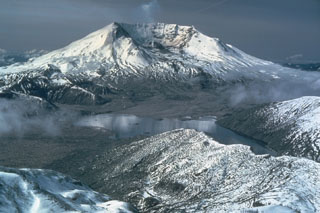Report on St. Helens (United States) — 10 May-16 May 2023
Smithsonian Institution / US Geological Survey
Weekly Volcanic Activity Report, 10 May-16 May 2023
Managing Editor: Sally Sennert.
Please cite this report as:
Global Volcanism Program, 2023. Report on St. Helens (United States) (Sennert, S, ed.). Weekly Volcanic Activity Report, 10 May-16 May 2023. Smithsonian Institution and US Geological Survey.
St. Helens
United States
46.2°N, 122.18°W; summit elev. 2549 m
All times are local (unless otherwise noted)
USGS reported that at 2045 on 14 May a debris flow in Mount St. Helens' South Coldwater Creek destroyed a Highway SR 504 bridge, cutting off access and power to Johnston Ridge Observatory. While the loss of power interrupted a major telemetry hub, other stations remined operational and continued to provide data; the debris flow was recorded in seismic data from nearby stations. The source material in the flow originated from the climactic 1980 debris avalanche and eruption of Mount St. Helens. According to a news article at least 11 people had to spend the night at the Johnston Ridge Observatory and were airlifted out the next day. Officials noted that the highway will be closed for an indefinite amount of time.
Geological Summary. Prior to 1980, Mount St. Helens was a conical volcano sometimes known as the Fujisan of America. During the 1980 eruption the upper 400 m of the summit was removed by slope failure, leaving a 2 x 3.5 km breached crater now partially filled by a lava dome. There have been nine major eruptive periods beginning about 40-50,000 years ago, and it has been the most active volcano in the Cascade Range during the Holocene. Prior to 2,200 years ago, tephra, lava domes, and pyroclastic flows were erupted, forming the older edifice, but few lava flows extended beyond the base of the volcano. The modern edifice consists of basaltic as well as andesitic and dacitic products from summit and flank vents. Eruptions in the 19th century originated from the Goat Rocks area on the N flank, and were witnessed by early settlers.
Sources: US Geological Survey Cascades Volcano Observatory (CVO), KING-TV

